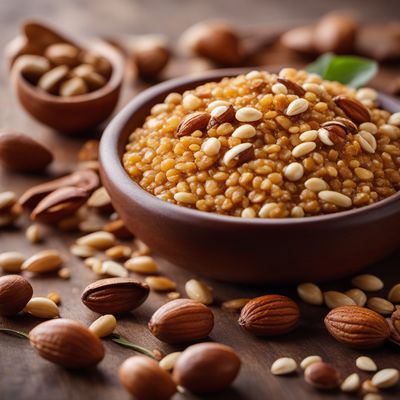
Ingredient
Candied or sugar preserved nuts
Sweet Delights: Exploring the World of Candied Nuts
Candied or sugar preserved nuts are made by coating nuts, such as almonds, pecans, or walnuts, with a sweet syrup made from sugar, water, and sometimes additional flavorings like vanilla or cinnamon. The nuts are then baked or roasted until the syrup caramelizes, creating a crunchy and sugary coating that enhances their natural flavors. The result is a delectable combination of textures, with the nuts providing a satisfying crunch and the sweet coating adding a delightful sweetness. These nuts can be enjoyed on their own as a snack, used as a topping for salads or desserts, or incorporated into baked goods like cookies or cakes.
Origins and history
The tradition of candying nuts can be traced back to ancient times, with evidence of candied nuts being enjoyed in ancient Rome and Persia. The technique of preserving nuts in sugar syrup was developed as a way to extend their shelf life and enhance their flavor. Over time, candied nuts became popular across different cultures and cuisines, with variations and regional specialties emerging. Today, candied nuts are enjoyed worldwide and are a staple in many holiday celebrations and festive occasions.
Nutritional information
Candied or sugar preserved nuts are a calorie-dense treat, providing a good source of healthy fats, protein, and dietary fiber. However, they are also high in sugar and should be enjoyed in moderation.
Allergens
Candied or sugar preserved nuts may contain allergens such as tree nuts, which can cause allergic reactions in some individuals.
How to select
When selecting candied or sugar preserved nuts, look for ones that have a glossy and evenly coated appearance. Avoid nuts that appear sticky or clumped together, as this may indicate poor quality or improper storage.
Storage recommendations
To maintain the freshness and quality of candied or sugar preserved nuts, store them in an airtight container in a cool, dry place. Avoid exposing them to moisture or heat, as this can cause the sugar coating to become sticky or melt.
How to produce
To produce candied or sugar preserved nuts at home, start by coating the nuts in a mixture of sugar, water, and any desired flavorings. Then, bake or roast the nuts in the oven until the sugar caramelizes and forms a crunchy coating. Allow the nuts to cool before enjoying or using them in recipes.
Preparation tips
Candied or sugar preserved nuts can be enjoyed as a standalone snack or used in various recipes. They can be added to salads for a sweet and crunchy element, used as a topping for ice cream or yogurt, or incorporated into baked goods like cookies or brownies. To enhance their flavor, consider adding spices like cinnamon or a sprinkle of sea salt.
Culinary uses
Candied or sugar preserved nuts are commonly used as toppings for desserts, such as cakes, pies, and ice cream sundaes. They can also be incorporated into cookies, brownies, or granola bars for added texture and sweetness. Additionally, candied nuts can be enjoyed on their own as a snack or used as a garnish for salads or roasted vegetables.
Availability
Candied or sugar preserved nuts are commonly available in grocery stores, specialty food stores, and online retailers. They can also be made at home using various nuts and flavorings.


